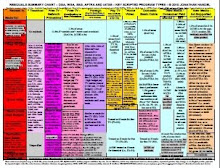This is a rather technical post:
Regarding the AMPTP-proposed SAG agreement, the media has been saying “The thresholds for new media work are $15,000 per minute, $300,000 per program, or $500,000 per series, whichever is lowest.” This is meant to describe what work is covered and what is not. (Note that there’s another prong: if any of the actors on the show is a “covered performer,” which roughly speaking means a professional, working actor, then the show is covered.)
However, “whichever is lowest” is meaningless or unclear: $15,000 is lower than both of the other numbers. Does that mean that the $15,000 threshold is what always applies, and the other figures don't mean anything? No, obviously not. Instead, the summary is loose and inaccurate.
The actual relevant language (from the WGA agreement, the AFTRA daytime agreement, and presumably from the other agreements as well) is:
[A production is not covered if] the actual cost of production is either: (a) $15,000 or less per minute of program material as exhibited, or (b) $300,000 or less per single production as exhibited, or (c) $500,000 or less per series of programs produced for a single order....The better way to summarize this is:
Productions aren’t covered if the production cost is either $15,000 or less per minute, or $300,000 or less per episode, or $500,000 or less per single order.BTW, note also that the media often say the $500,000 is “per series,” but it's actually per order. If the producer orders 22 episodes, then another 15, for instance, the $500,000 applies to the 22 episodes and/or the 15 episodes, not to all 37 episodes.
Note also the problem with “per order,” not “per series”: What if the production costs $20,000 per minute, $310,000 per episode, and $550,000 for the first order. It would be covered, because all of the figures are above the thresholds.
But then suppose the second order, of 15 episodes, costs $410,000. This below the threshold. Is the production suddenly non-covered? The language doesn't specify.
Also, suppose the order is reversed. Now the program starts out non-covered, then becomes covered. This presents problems as well. Again, the contract language doesn’t address this issue.
It’s a hard problem, since having a program flip-flop between covered and uncovered status is problematic, but having it permanently keep its original status doesn’t seem consistent with the spirit of the agreement (but maybe that’s the only solution). Also, the problem can’t be solved by saying “per series,” because a series could run for several years, and one wouldn’t know the series cost until the end. Also, “per season” would present the same problem as “per order” (and what is a “season” in made for new media anyway?).
There’s another problem as well, though maybe more theoretical than real: what if some episodes include “covered performers” and others don’t – are all episodes covered? Again, the language is silent.

